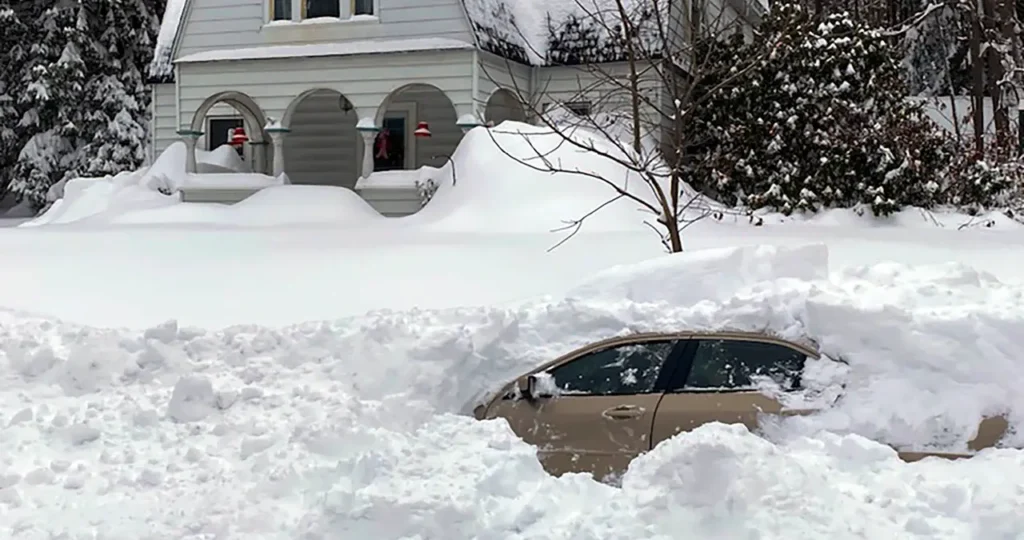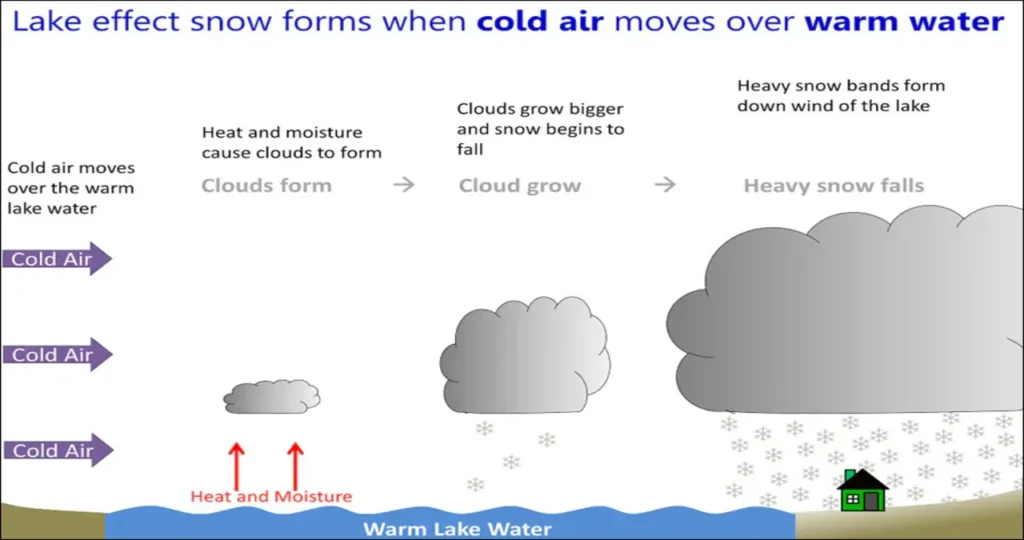Understanding Lake Effect Snow Warning: What You Need to Know

Understanding Lake Effect Snow Warning: What You Need to Know lake effect snow warning When winter rolls around, many of us brace ourselves for the inevitable snow. However, some regions experience a unique phenomenon known as lake-effect snow, which can lead to significant weather warnings. A “lake-effect snow warning” is issued when conditions are ripe for heavy snowfall due to the interaction between cold air and warmer lake waters lake effect snow warning. This article will delve into the intricacies of lake-effect snow, the science behind it, and what it means for those living in affected areas.
What is Lake Effect Snow?
Lake effect snow occurs when cold air moves over a relatively warmer body of water, such as a lake. This process can lead to intense snowfall in areas downwind of the lake lake effect snow warning. The phenomenon is most commonly associated with the Great Lakes in the United States, where the combination of cold Arctic air and warmer lake waters creates ideal conditions for heavy snow lake effect snow warning.
The mechanics of lake effect snow are fascinating. As cold air passes over the warmer lake, it picks up moisture from the water’s surface lake effect snow warning. This moisture then condenses into clouds and eventually falls as snow when the air rises and cools. The result can be localized snow bands that dump several inches of snow in a short period, often leading to hazardous travel conditions and significant snow accumulation.
The Science Behind Lake Effect Snow
To truly understand lake-effect snow, we need to investigate the science behind it. The process begins with temperature differences. During winter, the air above the lake can be significantly colder than the water itself, especially if the lake has not yet frozen over lake effect snow warning. This temperature contrast is crucial for the formation of lake-effect snow.
As the cold air moves over the warmer water, it heats up and becomes saturated with moisture. The warmer air rises, and as it does, it cools. When the air cools to its dew point, the moisture condenses into tiny water droplets, forming clouds lake effect snow warning. If the conditions are right, these clouds can grow and produce heavy snowfall. The snow can be particularly intense in narrow bands, leading to dramatic differences in snowfall amounts over short distances.
The Impact of Lake Effect Snow
Lake-effect snow can profoundly impact communities situated near large bodies of water. While some may enjoy the picturesque winter wonderland it creates lake effect snow warning, the reality is that lake-effect snow can lead to dangerous conditions. Roads can become treacherous, and visibility can drop significantly during heavy snow events.
Moreover, the localized nature of lake-effect snow means that some areas may receive several feet of snow while neighboring regions see little to no accumulation. This can create challenges for emergency services and snow removal efforts lake effect snow warning, as they must be prepared for rapidly changing conditions. Communities often have to adapt their winter preparedness plans to account for the unpredictability of lake-effect snow.
Lake Effect Snow Warning: What It Means
Meteorological agencies issue a lake effect snow warning when conditions are favorable for significant snowfall due to lake effect processes. This warning indicates that residents in the affected areas should prepare for heavy snow, which can lead to hazardous travel conditions and potential disruptions to daily life lake effect snow warning.
When a lake-effect snow warning is in effect, residents must stay informed about the latest weather updates. Local news stations, weather apps, and social media can provide real-time information about snowfall amounts, road conditions lake effect snow warning, and safety recommendations. Being proactive during these warnings can help individuals and families stay safe and minimize the impact of the snow.
Preparing for Lake Effect Snow

Preparation is key when a lake effect snow warning is issued. Residents in affected areas should take several steps to ensure their safety and readiness for the impending snow. First and foremost, it’s crucial to have an emergency kit on hand. This kit should include essentials such as food, water, medications, and other supplies that may be needed if travel becomes difficult lake effect snow warning.
Additionally, it’s wise to keep your vehicle winter-ready. This means ensuring that your tires are suitable for snowy conditions, your windshield wipers are functioning properly, and your gas tank is full. If you must travel during a lake effect snow event lake effect snow warning, consider leaving extra time for your journey and being prepared for potential delays.
The Role of Meteorologists in Lake Effect Snow Warnings
Meteorologists play a vital role in monitoring and predicting lake-effect snow events. Using advanced technology and models lake effect snow warning, they analyze weather patterns and conditions to determine when a lake-effect snow warning should be issued. Their expertise helps communities prepare for the impact of heavy snowfall and ensures that residents receive timely information.
In addition to issuing warnings, meteorologists also provide valuable insights into the expected duration and intensity of lake-effect snow events. This information can help individuals make informed decisions about travel and outdoor activities during winter storms lake effect snow warning. By understanding the science behind lake-effect snow, meteorologists can better communicate the risks and prepare communities for the challenges that come with heavy snowfall.
The Historical Context of Lake Effect Snow
Lake-effect snow has been part of the winter landscape in regions near large lakes for centuries. Historical records indicate that communities have long dealt with the challenges posed by heavy snowfall, often adapting their lifestyles and infrastructure to accommodate the unique weather patterns lake effect snow warning. For instance, towns near the Great Lakes have developed snow removal strategies and winter preparedness plans that take into account the unpredictable nature of lake-effect snow.
Over the years, advancements in meteorological technology have improved our understanding of lake effect snow. Historical data has been analyzed to identify patterns and trends, allowing meteorologists to refine their predictions lake effect snow warning. This historical context not only helps in forecasting but also provides valuable lessons for communities on how to respond to winter weather challenges effectively.
The Economic Impact of Lake Effect Snow
The economic implications of lake-effect snow can be significant, particularly in regions that rely on tourism and outdoor activities. While some businesses may benefit from increased winter sports traffic, others may suffer due to hazardous travel conditions and road closures lake effect snow warning. Local economies must adapt to the seasonal fluctuations caused by lake-effect snow, balancing the benefits and challenges it presents.
Moreover, the costs associated with snow removal and emergency services can strain municipal budgets. Communities often find themselves allocating substantial resources to manage the aftermath of heavy snowfall, which can impact other areas of public service lake effect snow warning. Understanding the economic impact of lake effect snow is crucial for local governments as they plan for winter weather and its associated costs.
Lake Effect Snow vs. Other Types of Snow
It’s important to distinguish lake-effect snow from other types of snowfall. While all snow is formed from moisture in the atmosphere, the mechanisms behind lake-effect snow are unique. For example, traditional snowstorms can cover large areas and result from widespread weather systems lake effect snow warning, whereas lake-effect snow is localized and often occurs in narrow bands.
This distinction is essential for understanding the different challenges posed by various types of snow. While a winter storm may bring steady snowfall over several days lake effect snow warning, lake-effect snow can lead to sudden and intense snowfalls that can catch residents off guard. Recognizing these differences can help individuals better prepare for the specific challenges associated with lake-effect snow.
Community Responses to Lake Effect Snow Warnings

Communities affected by lake-effect snow have developed various strategies to respond to warnings and mitigate the impact of heavy snowfall. Public awareness campaigns are often launched to educate residents about the risks associated with lake-effect snow and the importance of preparedness lake effect snow warning. These campaigns may include information on how to create emergency kits, safe driving practices, and the significance of staying informed during winter weather events.
Additionally, local governments often collaborate with meteorologists to ensure that accurate and timely information is disseminated to the public. This partnership helps to foster a culture of preparedness, where residents are encouraged to take proactive measures in anticipation of lake effect snow warnings.
The Future of Lake Effect Snow Predictions
As climate change continues to influence weather patterns, the future of lake effect snow predictions is an area of active research lake effect snow warning. Scientists are studying how rising temperatures and changing precipitation patterns may affect the frequency and intensity of lake-effect snow events. Understanding these trends is crucial for communities that rely on accurate weather forecasts to prepare for winter conditions.
Advancements in technology, such as improved satellite imagery and modeling techniques, are also enhancing our ability to predict lake-effect snow lake effect snow warning. These tools allow meteorologists to analyze atmospheric conditions in real-time, leading to more accurate and timely warnings. As our understanding of lake-effect snow evolves, so too will the strategies communities use to prepare for and respond to this unique winter phenomenon.
Conclusion: Embracing the Challenges of Lake Effect Snow
Lake effect snow is a fascinating and complex weather phenomenon that presents both challenges and opportunities for communities near large bodies of water. While it can lead to hazardous conditions and significant snowfall, it also contributes to the beauty of winter landscapes and supports winter sports and tourism lake effect snow warning.
By understanding the science behind lake-effect snow, the implications of warnings, and the importance of preparedness, residents can navigate the winter months with confidence. As we continue to learn more about this unique weather pattern lake effect snow warning, communities can adapt and thrive in the face of lake-effect snow, embracing the challenges it brings while enjoying the beauty of winter lake effect snow warning.




